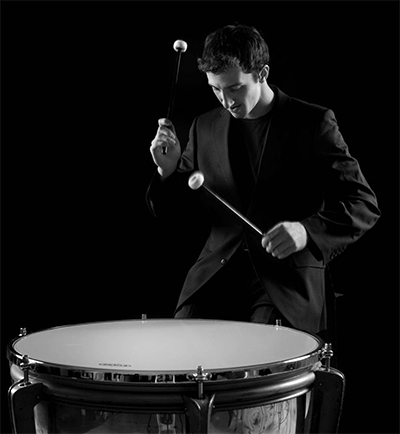by Mike Telin

On Tuesday, June 25 at 7:30 in CIM’s Mixon Hall, you can hear Cohen perform Eötvös’ intriguing work. The program will also include Liszt’s Orpheus arranged for piano trio by Saint-Saéns, selections from Brahms’ Hungarian Dances, and Erno Dohnányi’s Piano Sextet. Tickets are available online.
Thunder is a single movement from the composer’s larger work Triangel for percussion and ensemble. Scored for a single drum, the graphically-notated piece involves rhythmic patterns played while constantly pedaling. Although the pitch is continually changing, no specific pitch is indicated.
Cohen said that a typical set of timpani consists of four or five drums, the smallest being 20 inches in diameter and the largest 31 or 32 inches in diameter. How did he decide which drum to use? “The title is Thunder for solo bass timpani, so I grabbed the 32-inch because that was the largest drum I had access to.”
Timpani have pedal mechanisms that the player uses to adjust the pitch. In Thunder, Eötvös uses the single drum as an unpitched percussion instrument, while continually varying the tone. “If I were to tell a composer how to write a timpani piece I would be coming at it from a timpanist’s perspective — thinking about the instrument’s role in the orchestra and using orchestral techniques. With this piece, it’s almost as though he looked at music for other percussion instruments and employed those techniques, while also exploiting the options that the pedal mechanism provides.”
The piece calls for some unusual techniques. “Usually, when we strike the timpani we let the stick bounce off quickly because the longer the stick stays on the drumhead, the less resonant the sound is — and in the orchestra, you want the sound to be as resonant as possible. But Eötvös writes dead strokes, where you strike the drum and leave the stick on the head — you don’t let it bounce off. He also has you playing on the rim.”
Thunder includes a cadenza which gives the performer the opportunity to add creativity to the mix. “I’m using some techniques that he didn’t write in the rest of the piece, like cutting a superball in half and attaching it to a stick — when you rub it against the drum head it produces a moaning sound.”
Eötvös’ graphic notation is on the simple side — just the standard staff with the middle three lines removed. “The gestures are indicated within that. So I’m looking at a gesture that is notated visually, and then figuring out what part of the pitch range that gesture should be in — you just tinker around and figure out where it fits best. He also writes a lot of glissando.”
The timpanist said the biggest hurdle to learning the piece was freeing himself from the constraints of what is typical. “Musicians are wired to fit within the chromatic grid of pitches. Just using the pedal and not thinking of half steps and whole steps is unusual, and at first it was challenging. You have to open your mind to sounds, colors, and techniques that the constraints of an orchestra don’t allow you to explore. It can be fun if you can free yourself from the orchestral attitude.”
Cohen said that he looks forward to performing the piece at ChamberFest. “There will be some surprises for the audience, but it’s going to be a fun exploration.”
Published on ClevelandClassical.com June 18, 2019.
Click here for a printable copy of this article

